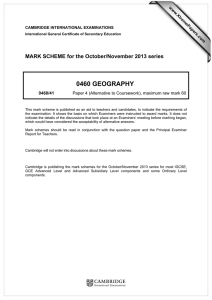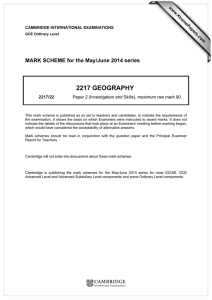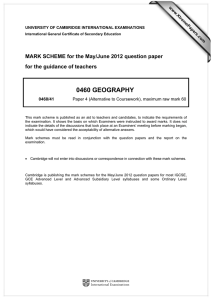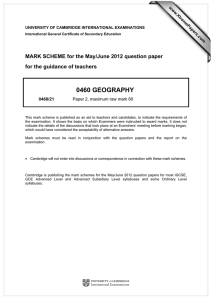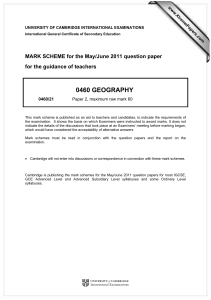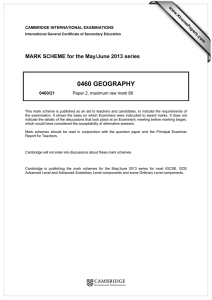0460 GEOGRAPHY MARK SCHEME for the May/June 2014 series
advertisement
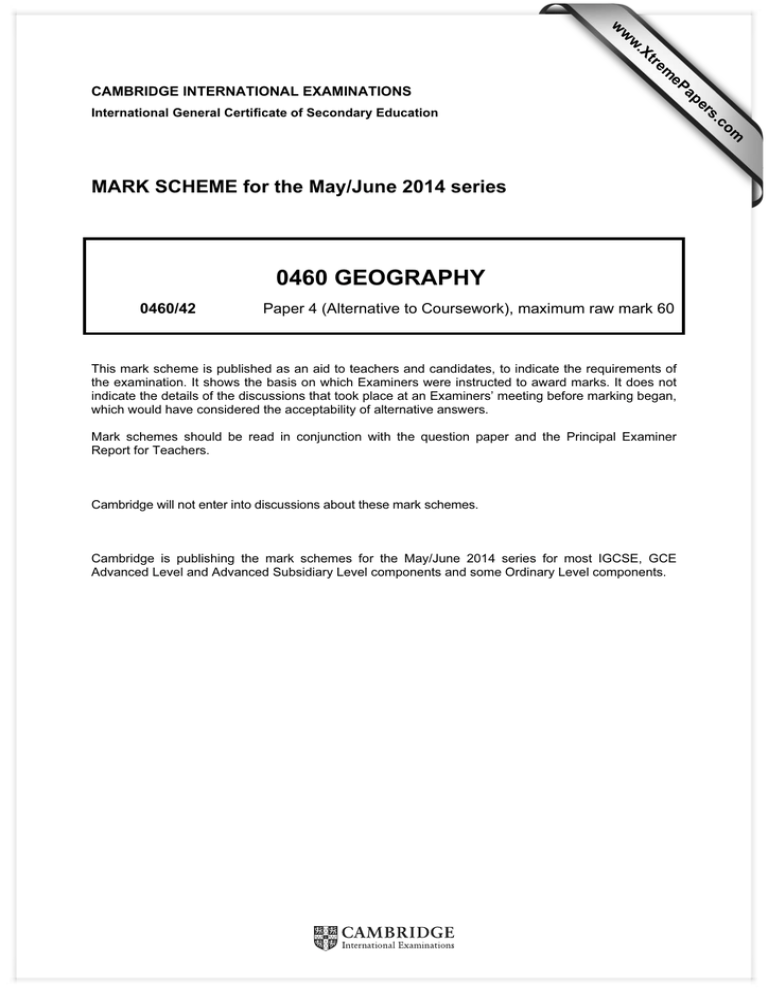
w w ap eP m e tr .X w CAMBRIDGE INTERNATIONAL EXAMINATIONS 0460 GEOGRAPHY 0460/42 Paper 4 (Alternative to Coursework), maximum raw mark 60 This mark scheme is published as an aid to teachers and candidates, to indicate the requirements of the examination. It shows the basis on which Examiners were instructed to award marks. It does not indicate the details of the discussions that took place at an Examiners’ meeting before marking began, which would have considered the acceptability of alternative answers. Mark schemes should be read in conjunction with the question paper and the Principal Examiner Report for Teachers. Cambridge will not enter into discussions about these mark schemes. Cambridge is publishing the mark schemes for the May/June 2014 series for most IGCSE, GCE Advanced Level and Advanced Subsidiary Level components and some Ordinary Level components. om .c MARK SCHEME for the May/June 2014 series s er International General Certificate of Secondary Education Page 2 1 Mark Scheme IGCSE – May/June 2014 Syllabus 0460 Paper 42 (a) (i) Examples Keep together/stay as a group (1) Don’t get lost/stick to paths/stay in designated area (1) Use a map/compass (1) Wear boots/ appropriate clothes/suitable clothing (1) Don’t climb trees (1) Take a mobile phone (1) Stay away from wild animals (1) Use insect repellent/sunblock etc. (1) [1 + 1 + 1 = 3] (ii) Similarities: Same length/400 metres long (1) Start at same place/height/380 metres (1) Go from grassland into woodland/both start in grassland (1) Both downhill/sloping (1) Both straight (1) Both cross a land-use boundary (1) Differences: Go in different direction (1) Transect X is W-E/goes east, transect Y is S-N/goes north (1) Transect X is gentler (1) Transect X goes down to 321/339m (in range), Y goes down to 300m/Y goes to lower height (1) Transect X is in coniferous wood, transect Y is in deciduous wood (1) [2 + 2 = 4] (b) (i) Systematic [1] (ii) Examples To get an equal distribution of sites/ fair/consistent/no bias (1) To show how results change along transect (1) Gap between sites is not too big to miss change in results/get a good range (1) 25 metres is an easy length with a tape measure (1) If < 25 metres very time-consuming (1) By using 17 sites per transect can get a lot of data (1) [1 + 1 = 2] (c) (i) Examples Easy to read/use/less chance of error (1) Quick/saves time/ instant measurement (1) Accurate / precise/sensitive/ gives decimal point (1) [1 + 1 = 2] (ii) 35 – 37 % = 2 marks 32 – 34% or 38 – 40% = 1 mark [2] (iii) 8.4C [1] (iv) Completion of temperature line graph – 1 mark per plot 4.4 oC at 275m & 6.7 oC at 300m © Cambridge International Examinations 2014 [1 + 1 = 2] Page 3 Mark Scheme IGCSE – May/June 2014 Syllabus 0460 Paper 42 (v) Completion of sky bar graph – 1 mark per bar 70% at 150m & 62% at 300m [1 + 1 = 2] (vi) Sky percentage is higher in grassland than woodland/ lower in woodland than in grassland (1) Sky percentage is = > 95% in grassland but = <92% in woodland (1) [1] (d) (i) One mark reserved for decision on hypothesis. TRUE/AGREE with Hypothesis. OR Temperatures are lower in coniferous woodland / higher in deciduous woodland Evidence from Fig 3: Coniferous temperatures 4.4 – 7 oC but deciduous temperatures 6.3–8.2 oC (1) Highest 8.2 oC in deciduous but only 7 oC in coniferous (1) Coniferous has figures below 6.3 oC but deciduous all = > 6.3C (1) Average temperature in coniferous 5.7 oC but higher average 7.1 oC in deciduous (1) [(1R + 1 + 1) = 3] (ii) Examples of evidence Sky results are lower in coniferous woodland or X / higher in deciduous woodland or Y(1) Coniferous percentage/X 32–92% but deciduous/Y percentage 55 – 90% (1) Average percentage lower/53.9/54% in coniferous/X OR higher/66.6/67% in deciduous/Y (1) Percentage of sky in deciduous/Y not below 55% but in coniferous/X lowest is 32% (1) [1 + 1 = 2] (iii) Examples (Answers can be from deciduous point of view) Can refer to A = Coniferous and B = Deciduous Trees are closer together in coniferous woodland/A (1) Leaf/canopy cover is denser in coniferous woodland/A (1) Less sunlight can penetrate coniferous woodland/A (1) Less sunlight/higher shade in coniferous woodland/A (1) [1 +1 = 2] (e) Examples Extend transects (1) Take more measurements/sites into woodland/smaller distance between measuring sites (1) Two/more people take same readings and check results (1) Use two thermometers (1) Take measurements at same time / not morning and afternoon (1) Better to do study over several days to get more reliable/average results (1) Use a mirror/light meter to measure sky/light (1) [1 + 1 + 1 = 3] [Total: 30 marks] © Cambridge International Examinations 2014 Page 4 2 Mark Scheme IGCSE – May/June 2014 Syllabus 0460 Paper 42 (a) (i) Examples Opportunity to test descriptions are appropriate (1) Opportunity to test that all features are covered in survey (1) Practise/improve methodology/know what to do (1) Check consistency of applying scoring criteria (1) [1 + 1 = 2] (ii) Examples Filled in/circled the location (1) Look at/observe each feature (1) Made a decision/give opinion about the score for each category (1) Put a tick/record/give score/mark in the appropriate row/box (1) Add up/work out total in column (1) [1 + 1 = 2] (iii) Examples: 1 for each suggestion and 1 for each reason Work in groups (1) So other students check scores (1) Makes results less subjective / biased/consistent/can take an average (1) Go to different areas (1) So they survey as many roads as possible in each area (1) Gives a larger sample (1) Makes efficient use of time (1) Do surveys on same day / at same time / under same conditions (1) So comparisons between areas more consistent (1) (b) (i) Total = +11 + sign not essential (ii) Completion of graphs for areas A (+1) and B (–3). [2 × (1 + 1) = 4] [1] [1 + 1 = 2] (iii) Examples: Need 4 references to data/the table. Area C/newest has highest score/+11 (1) compared to +6/–14 (1) Area C/newest has 7 positive scores/only 1 negative/mostly positive/ vandalism & graffiti only negative (1) Area A/oldest does not have lowest score (1) is +6 compared to –14 (1) Area A/oldest has positive total score / 6 positive scores (1) Area B/middle age has lowest/negative score (1) of –14 compared to +6/+11 (1) Area B has negative score in all 8 categories (1) [1 + 1 + 1 + 1 = 4] (c) (i) Stratified only acceptable Examples of reasons for Stratified Will get people from different age groups (1) Will get people from different genders (1) Will get people from different socio-economic groups (1) © Cambridge International Examinations 2014 [1R + (1 + 1) = 3] Page 5 Mark Scheme IGCSE – May/June 2014 Syllabus 0460 Paper 42 (ii) Hypothesis is partly true/false/untrue/incorrect Evidence True for parking and traffic in areas A & B (1) with 3.8 and 3.3 (1) or with 3.8 higher than the other two for parking (1) or with 3.7 higher than others for traffic (1) Parking not true for area C (1) with 1.8 being lowest (1) Traffic not true for area C (1) with 1.5 being lowest (1) Scores in areas A & B = agree / strongly agree (1) as more above 3 (1) Scores in area C = disagree / strongly disagree (1) as more below 2 (1) If no decision given credit evidence for correct hypothesis to max 3 [(1R + 1 + 1 + 1) = 4] (iii) Completion of divided bar graph 1 mark for both dividing lines at correct values from the left (20 & 39) 1 mark for shading in correct order and direction from the left. [1 + 1 = 2] (iv) Parking examples Create more off-road parking areas / car parks/multi-storey parking / underground parking or garaging (1) Create permit parking system/residents reserved spaces (1). ALSO Park and ride schemes (Max 1 if in both) Traffic examples Build by-pass / ring road / one way system/flyover (1) Exclude heavy vehicles from residential areas (1) Congestion level charging at peak times of day (1) Better public transport/bus lanes (1) Odd/even number plates on different days (1) Cycle lanes (1) Car sharing (1) © Cambridge International Examinations 2014 [1 + 1 = 2] Page 6 Mark Scheme IGCSE – May/June 2014 Syllabus 0460 Paper 42 (d) Must be plausible NEW investigations that could be carried out in the three housing areas; not those already done in the Question i.e. NOT any of those listed in Table 2 and NOT Parking/Traffic from Table 4. Examples of new ideas that are deemed implausible/inappropriate but can get max 2 for how they would carry them out. Income, employment, health, population structure, type of housing. Examples of possible ideas OK for max marks = 4. Price of houses (1) Access for services/shopping (1) Safety of an area (1) Litter (1) Height of buildings (1) 1 Appropriate methods such as: Questionnaire (1) House price survey (1) Convenience index (1) Mark on maps (1) Credit details of how such a study would be done inc. recording. [1R + 3 = 4] [Total: 30 marks] © Cambridge International Examinations 2014
